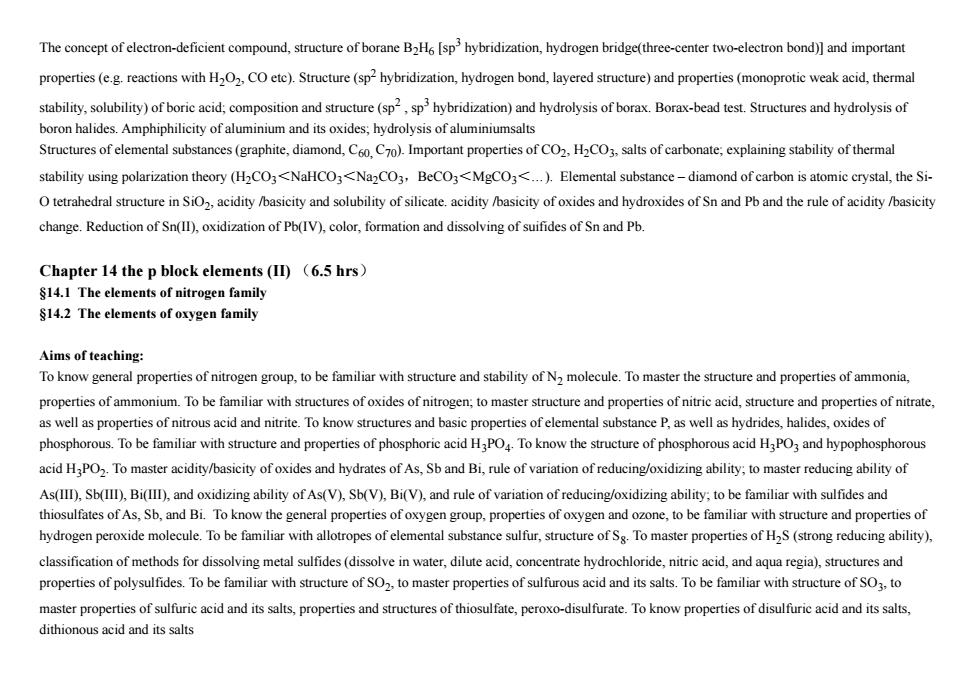正在加载图片...

The concept of electron-deficient compound,structure of borane B2H6 [sp'hybridization,hydrogen bridge(three-center two-electron bond)]and important properties (e.g.reactions with H2COete).Structure(sp2 hybridization,hydrogen bond,layered structure)and properties (monoprotic weak acid,thermal stability,solubility)of boric acid:composition and structure(sp2,sp hybridization)and hydrolysis of borax.Borax-bead test.Structures and hydrolysis of boron halides.Amphiphilicity of aluminium and its oxides;hydrolysis of aluminiumsalts Structures of elemental substances(graphite,diamond,Co C7o).Important properties of CO2.H2CO.salts of carbonate,explaining stability of thermal stability using polarization theory (H2CO:<NaHCO<NaCO3,BeCO3<MgCO3<...)Elemental substance-diamond of carbon is atomic crystal,the Si- O tetrahedral structure in SiO,,acidity/basicity and solubility of silicate.acidity /basicity of oxides and hydroxides of Sn and Pb and the rule of acidity /basicity change.Reduction of Sn(Il),oxidization of Pb(IV).color,formation and dissolving of suifides of Sn and Pb. Chapter 14 the p block elements(II)(6.5 hrs) $14.1 The elements of nitrogen family $14.2 The elements of oxygen family Aims of teaching: To know general properties of nitrogen group,to be familiar with structure and stability of N molecule.To master the structure and properties of ammonia, properties of ammonium.To be familiar with structures of oxides of nitrogen;to master structure and properties of nitric acid,structure and properties of nitrate. as well as properties of nitrous acid and nitrite.To know structures and basic properties of elemental substance P,as well as hydrides,halides,oxides of phosphorous.To be familiar with structure and properties of phosphoric acid HPO To know the structure of phosphorous acid HPO and hypophosphorous acid HPO2.To master acidity/basicity of oxides and hydrates of As,Sb and Bi,rule of variation of reducing/oxidizing ability;to master reducing ability of As(III).Sb(III),Bi(III),and oxidizing ability of As(V),Sb(V).Bi(v),and rule of variation of reducing/oxidizing ability:to be familiar with sulfides and thiosulfates ofAs,Sb,and Bi.To know the general properties of oxygen group.properties of oxygen and ozone,to be familiar with structure and properties of hydrogen peroxide molecule.To be familiar with allotropes of elemental substance sulfur,structure of Sg.To master properties of H2S(strong reducing ability), classification of methods for dissolving metal sulfides(dissolve in water,dilute acid,concentrate hydrochloride,nitric acid,and aqua regia).structures and properties of polysulfides.To be familiar with structure of SO2,to master properties of sulfurous acid and its salts.To be familiar with structure of SO3,to master properties of sulfuric acid and its salts,properties and structures of thiosulfate,peroxo-disulfurate.To know properties of disulfuric acid and its salts, dithionous acid and its saltsThe concept of electron-deficient compound, structure of borane B2H6 [sp3 hybridization, hydrogen bridge(three-center two-electron bond)] and important properties (e.g. reactions with H2O2 , CO etc). Structure (sp2 hybridization, hydrogen bond, layered structure) and properties (monoprotic weak acid, thermal stability, solubility) of boric acid; composition and structure (sp2 , sp3 hybridization) and hydrolysis of borax. Borax-bead test. Structures and hydrolysis of boron halides. Amphiphilicity of aluminium and its oxides; hydrolysis of aluminiumsalts Structures of elemental substances (graphite, diamond, C60, C70 ). Important properties of CO2 , H2CO3 , salts of carbonate; explaining stability of thermal stability using polarization theory (H2CO3<NaHCO3<Na2CO3,BeCO3<MgCO3<…). Elemental substance – diamond of carbon is atomic crystal, the SiO tetrahedral structure in SiO2 , acidity /basicity and solubility of silicate. acidity /basicity of oxides and hydroxides of Sn and Pb and the rule of acidity /basicity change. Reduction of Sn(II), oxidization of Pb(IV), color, formation and dissolving of suifides of Sn and Pb. Chapter 14 the p block elements (II) (6.5 hrs) §14.1 The elements of nitrogen family §14.2 The elements of oxygen family Aims of teaching: To know general properties of nitrogen group, to be familiar with structure and stability of N2 molecule. To master the structure and properties of ammonia, properties of ammonium. To be familiar with structures of oxides of nitrogen; to master structure and properties of nitric acid, structure and properties of nitrate, as well as properties of nitrous acid and nitrite. To know structures and basic properties of elemental substance P, as well as hydrides, halides, oxides of phosphorous. To be familiar with structure and properties of phosphoric acid H3PO4 . To know the structure of phosphorous acid H3PO3 and hypophosphorous acid H3PO2 . To master acidity/basicity of oxides and hydrates of As, Sb and Bi, rule of variation of reducing/oxidizing ability; to master reducing ability of As(III), Sb(III), Bi(III), and oxidizing ability of As(V), Sb(V), Bi(V), and rule of variation of reducing/oxidizing ability; to be familiar with sulfides and thiosulfates of As, Sb, and Bi. To know the general properties of oxygen group, properties of oxygen and ozone, to be familiar with structure and properties of hydrogen peroxide molecule. To be familiar with allotropes of elemental substance sulfur, structure of S8 . To master properties of H2S (strong reducing ability), classification of methods for dissolving metal sulfides (dissolve in water, dilute acid, concentrate hydrochloride, nitric acid, and aqua regia), structures and properties of polysulfides. To be familiar with structure of SO2 , to master properties of sulfurous acid and its salts. To be familiar with structure of SO3 , to master properties of sulfuric acid and its salts, properties and structures of thiosulfate, peroxo-disulfurate. To know properties of disulfuric acid and its salts, dithionous acid and its salts